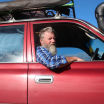Electric 4X4 anyone? It kind of makes sense that, as the rest of the car market transits towards an EV future, that the four-wheel drive market would, too. It is, of course, not that simple. The term all-wheel drive electric car is not specific enough, just for starters.
So, let’s start with a couple of definitions: When we’re talking about a 4-wheel drive, we mean an off-road capable vehicle with the sort of abilities that have made recreational off-roading so popular in this country. And when we say electric, we mean fully battery-electric. So, a purely electric off-road vehicle, then.
You see, there are plenty of cars that are battery-electric and possess four-wheel drive, but none of them match the criteria for off-road performance. Plenty offer hybrid and plug-in hybrid capability, too, and there’s a wealth of choice if you’re in the market for such a thing. But an off-roading vehicle with a BEV driveline? Not yet, folks.
Probably the closest you’ll get in new-car showrooms right now is a Land Rover or Range Rover with a hybrid driveline, and there are others like the Great Wall tank twins - the Tank 300 and Tank 500 - that are off-road capable and available with hybrid powertrains.
It’s also worth mentioning the latest version of the popular Toyota HiLux can also be had with a mild-hybrid driveline. Although it’s very, very mild.
Right now, the closest you’ll get to a rough and tough off-roader with an EV heart is something like a Subaru Soltera or a vehicle of that ilk, but while it has an electic driveline, it’s definitely more of an SUV than an off-roader.
This is not to say, however, that a pure-electric off-roader won’t happen. There are plenty in the pipeline as the world’s carmakers make the shift to electrons, but, typically, we won’t see them all in Australia.
.jpg)
Chief among that list of cars is the curiously-styled Tesla Cybertruck (an electric 4WD ute) which has been ruled out for this market, but represents a novel take on the concept of an EV 4X4.
Others that have been tipped to perhaps arrive here in the next handful of years include the Mercedes-Benz EQG, a dual-cab 4X4 ute from LDV (there’s already a two-wheel drive one) and perhaps even Ford’s F-150 Lightning electric vehicle.
The Ineos Fusilier is tipped to arrive here in 2026, too, although whether we’ll see both the hybrid and BEV driveline options remains to be seen.
Those would all have the potential for emissions-free off-roading, but we’ll also be seeing future electric cars in the form of some new plug-in hybrids like the VW Amarok, the much hyped Kia Tasman ute in hybrid form and even a ute version of Hyundai’s forthcoming EV platform.
Meantime, an electric 4X4 Australia seems like a challenging market to us. We have the wide open spaces that make off-roading such a great pursuit, but that same geography and sparse populations away from the seaboard mean that charging infrastructure might be difficult and expensive to achieve.
And while it’s one thing to be able go camping for a few days and charge your phone or laptop from a small solar array, that wouldn’t be viable for an EV 4WD which needs a lot more power than a portable solar array could muster.
The physical proportions and attributes of an off-roader also play against electrification. They tend to be pretty poor aerodynamically, (already) heavy even without batteries and many owners like to tow with them which, as testing has shown, is a great way to shorten an EV’s range by an alarming factor.
Perhaps the PHEV (Plug-in Hybrid Electric Vehicle) 4WD is the better bet for now. These would give city dwellers the opportunity to travel to work emissions-free through the week, while continuing to explore the great outdoors on weekends via the ICE (Internal Combustion Engine) component of the driveline.
.jpg)
In fact, you could drive a plug-in hybrid 4X4 Australia wide and not experience range anxiety while ever there’s a service station every few hundred kilometres.
Of course, it’s also true that if you really only want to discover unsealed roads (as opposed to high-country trails) then an SUV with all-wheel drive is probably all you need.
This is something the existing 4WD electric car or hybrid pack could manage right now. At which point, your choices open up enormously. That said, the scarcity of charging points in the outback would still make a pure-electric vehicle somewhat less than viable.
But what if we looked a bit further into the future of the 4WD electric car. Perhaps the best solution for a nation like ours would be a diesel-electric hybrid where the diesel engine runs to create electricity for the electric motor(s).
.jpg)
This technology has been used in freight trains for decades with great results in terms of reliability, efficiency and range. And yet, it’s a concept in which very few carmakers seem interested.
.jpg)
.jpg)

.jpg)
.jpg)
.jpg)
.jpg)

.jpg)

_0.jpg)

.jpg)
.jpg)
.jpg)
.jpg)
.jpg)
.jpg)
.jpg)
.jpg)






_0.jpg)
.jpg)


.jpg)

